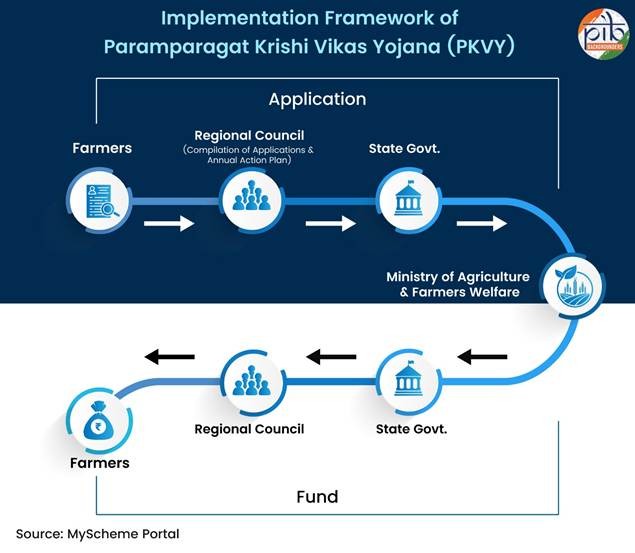1. Background and Introduction
Launched: 2015
Under: National Mission for Sustainable Agriculture (NMSA)
Nodal Ministry: Ministry of Agriculture and Farmers Welfare
Objective:
Promote organic farming through cluster-based approaches.
Restore soil health and ecological balance.
Improve farmers’ income through low-cost, sustainable agriculture.
Strengthen food safety and environmental sustainability.
2. Financial Outlay and Achievements (As of 2025)
Funds Released (2015–25): ₹2,265.86 crore
Funds Released (FY 2024–25): ₹205.46 crore under Rashtriya Krishi Vikas Yojana (RKVY)
Area Covered: ~15 lakh hectares under organic farming
Clusters Formed: 52,289
Farmers Benefitted: 25.30 lakh (as of Feb 2025)
Digital Presence:
Jaivik Kheti Portal – 6.23 lakh farmers, 19,016 groups, 89 input suppliers, and 8,676 buyers registered (by Dec 2024).
3. Objectives of PKVY
Promote organic agriculture by adopting eco-friendly farming methods.
Enhance soil fertility and microbial activity through reduced chemical use.
Develop self-sustaining farming models based on local resources.
Encourage farmer collectives through cluster formation (20 ha per cluster).
Ensure market linkages for organic produce and fair price realization.
4. Eligibility Criteria
Who can apply:
All farmers and farming institutions with up to 2 hectares of land.
Cluster Formation:
Minimum cluster size: 20 hectares.
Farmers within a cluster adopt organic farming collectively to maintain uniform standards.
5. Financial Assistance and Benefits
Each farmer receives ₹31,500 per hectare for 3 years, distributed as follows:
| Component | Description |
|---|---|
| On-farm & Off-farm Inputs | Bio-fertilizers, compost units, green manure |
| Marketing & Branding | Packaging, branding, and transport |
| Certification & Testing | PGS certification, residue analysis |
| Training & Capacity Building | Farmer training, exposure visits, workshops |
Encourages direct farmer-to-consumer sales through the Jaivik Kheti Portal.
Promotes domestic and international branding of organic products.
Builds consumer trust in Indian organic produce.
6. Implementation Mechanism
Regional Councils (RCs):
Farmers approach RCs for enrollment and certification guidance.
RCs consolidate proposals into an Annual Action Plan (AAP).
Approval & Funding:
AAP submitted to Ministry of Agriculture for approval.
Central Government allocates funds to State Governments.
States → RCs → Farmers via Direct Benefit Transfer (DBT).
Transparency:
Ensures timely, corruption-free fund transfer and accountability.
7. Certification Systems under PKVY
PKVY promotes two parallel certification mechanisms:
(a) NPOP (National Programme for Organic Production)
Type: Third-party certification.
For: International export markets.
Ensures: Compliance with global organic standards for production, processing, and trade.
(b) PGS-India (Participatory Guarantee System)
Type: Community-based certification.
For: Domestic markets.
Involves: Peer inspections, collective verification by farmer groups.
Ideal for: Small and marginal farmers due to low cost and local accountability.
8. Large Area Certification (LAC) Scheme
Launched: 2020–21 (under PKVY).
Purpose: Fast-track organic certification in areas never exposed to chemical farming (tribal belts, islands, forest fringes).
Key Features:
Reduces conversion time from 2–3 years to a few months.
Certifies large, contiguous areas under organic farming.
Enhances income, market access, and export competitiveness.
Example: Sikkim fully certified as an organic state under LAC.
9. Digital Support: Jaivik Kheti Portal
Launched by: Ministry of Agriculture.
Purpose: Connects farmers directly to consumers and markets.
Functions:
Enables direct sale of organic produce.
Lists buyers, suppliers, certifiers, and farmers.
Promotes transparency and traceability in organic supply chains.
10. Impact on North-East India
| State/Region | Area Covered (ha) | Farmers Benefitted | **Funds Allocated (Approx.) | Remarks |
|---|---|---|---|---|
| Assam | 4,400 | 9,740 | ₹3,013 crore | Significant organic shift under PKVY |
| Sikkim | 63,000 | — | ₹1,849 crore | Fully organic state (LAC model) |
| Other NE States (Arunachal, Mizoram, Manipur, Nagaland, Tripura, Meghalaya) | 4,140 | — | ₹2,337 crore | Expanding organic base in tribal areas |
Key Takeaway:
The North-East region, due to low chemical use, is ideal for organic expansion.
Boosted employment, income, and eco-tourism potential.
11. Overall Outcomes and Significance
Environmental: Reduction in soil and water contamination.
Economic: Better price realization through organic branding.
Social: Strengthened farmer communities through collective farming.
Technological: Integration with digital platforms and traceable certifications.
Sustainability: Aligns with India’s commitment to SDG 2 (Zero Hunger) and SDG 12 (Sustainable Consumption & Production).
12. Challenges and Way Forward
| Challenges | Way Forward |
|---|---|
| Lack of awareness among small farmers | More training and demonstration projects |
| Certification costs | Expand subsidized PGS certification |
| Market access issues | Strengthen Jaivik Kheti Portal and FPO networks |
| Limited post-harvest infrastructure | Create organic processing zones |
| Low yield during transition phase | Introduce support price or insurance mechanisms |
13. Conclusion
The Paramparagat Krishi Vikas Yojana (PKVY) has emerged as a cornerstone of India’s organic farming revolution. By integrating traditional wisdom with modern certification systems, PKVY not only enhances farmers’ income but also ensures long-term ecological sustainability. As India moves toward becoming a global leader in organic agriculture, schemes like PKVY serve as a model of sustainable rural transformation.
🔗 For more UPSC-preparation blogs and detailed notes, visit www.victorgrowth.com






